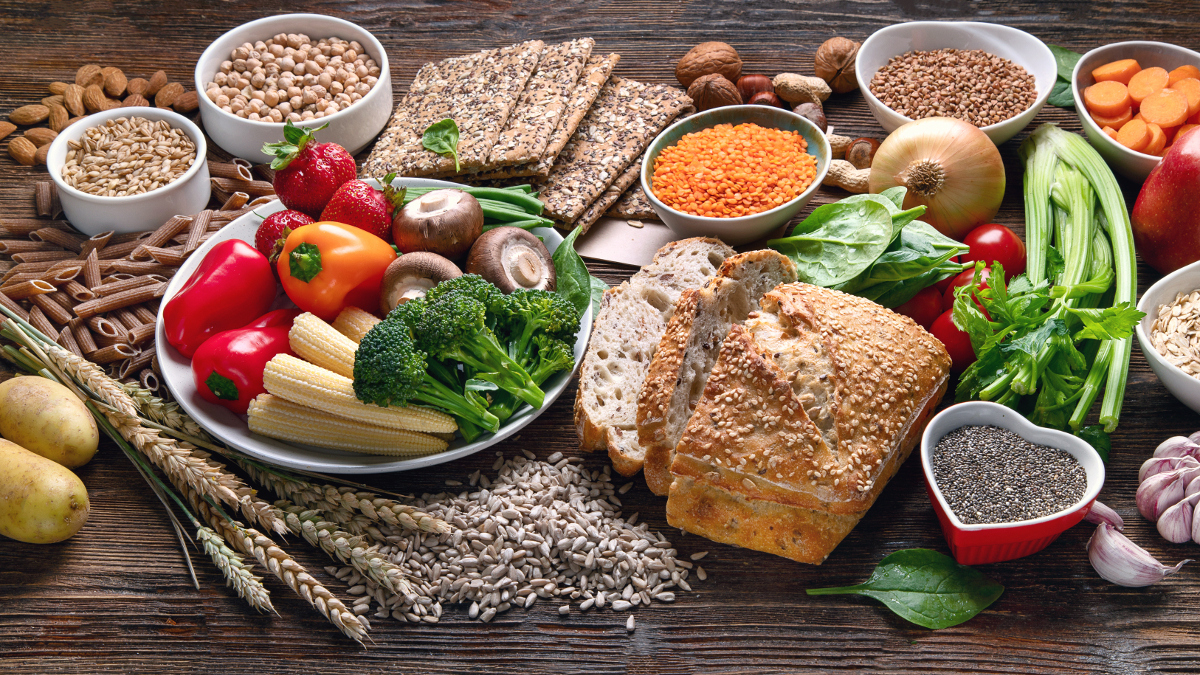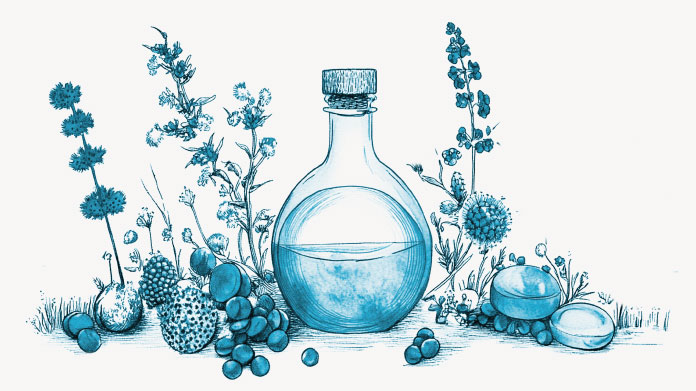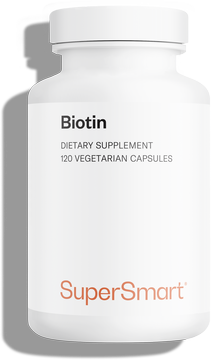Fibre: role, foods and supplements
Far from being just another diet fad, the call to eat more fibre is actually based on recent scientific evidence of the role it plays in maintaining our health. Discover why you should increase your intake of dietary fibre, and how to do so.

Everything you need to know about dietary fibre, a good friend to your gut
A carbohydrate like no other
Fibre refers to a group of substances which are a type of carbohydrate, and which are primarily classified as polysaccharides. Fibre has the distinct feature of being used by the body despite not being completely broken down or absorbed.
There are many types of fibre (1) : pectin, beta-glucans, inulin, gums, psyllium, fructo-oligosaccharides (which you’ll find in the supplement Fructo-Oligosaccharides), galacto-oligosaccharides, cellulose, hemicellulose, etc.
Fibre is usually classified as being either soluble (primarily found in fruit and vegetables) orinsoluble (mainly present in grains and pulses).
The role played by different types of fibre
Originally, it was thought that fibre was of no benefit to health as, unlike other food groups, it is not digested in the small intestine. But more recently, it has attracted renewed interest with studies revealing the role it plays in digestion (2-4).
Insoluble fibre primarily has a mechanical function in gastrointestinal transit (5). In absorbing water and remaining undigested, it increases the volume of the food bolus which arrives in the gut, thus activating intestinal motility. The presence of a substantial food bolus encourages the gut – effectively a muscle – to contract.
Thus, insoluble fibre promotes GI transit naturally and gently, without producing the rapid and sometimes unpleasant effect of foods such as prunes (these work using a different process).
With regard to soluble fibre, it dissolves in water in the digestive system and becomes more viscous, forming a kind of gel. In this way, it extends the time the food bolus stays in the digestive system which optimises the absorption of a number of metabolites (6).
Unlike other food groups which are digested in the small intestine, soluble fibre is only digested in the large intestine, where it is fermented by certain enzymes, and where it delivers numerous nutrients to the gut microbiota (7).
How much fibre do you need to stay healthy?
The EFSA’s Panel on Dietetic Products, Nutrition and Allergies has established dietary reference values for intake of carbohydrates, dietary fibre, fats and water (8).
According to this European body, the amount of dietary fibre needed for normal gut function in adults is 25 grams a day.
It adds that a higher adult fibre intake is probably beneficial for health (by helping to both reduce the risk of heart disease and type 2 diabetes, and maintain a healthy weight).
To stay healthy, it’s therefore important - whatever your age - to maximise your dietary fibre intake, especially insoluble fibre.
Too much fibre – what are the risks?
Excess fibre is never toxic for the body. However:
- eating large amounts of raw food sources of soluble fibre can cause potentially unpleasant flatulence and bloating ; (9)
- insoluble fibre is said to irritate the bowel and those suffering from IBS may similarly experience discomfort; (10)
- since all fibre absorbs a lot of water, it’s important to stay sufficiently hydrated when eating a high-fibre diet, with at least 2 litres of fluid a day for women, and 2.5 litres for men (excluding any additional fluid needed to compensate for water lost through exercise-induced perspiration).
In all cases, if you suffer from any bowel or digestion-related disease, you are strongly advised to consult your doctor and/or nutritionist before making any changes to your diet.
Fibre-rich foods
“Make sure you get your 5-a-day!” This somewhat simplistic message contains an undeniable truth: that eating at least 5 portions of fruit and vegetables a day is a good starting point towards ensuring a reasonable fibre intake.
Take care, however, not to rely on fruit or vegetable juices to meet your requirements: in the juice production process, the fibre gets removed!
It’s also advisable to minimise your consumption of refined cereals, and instead eat their unrefined counterparts: wholegrain rice, whole wheat, oats, etc. which are also high in fibre.
In short, an eating plan that’s similar to an acid-base or paleo diet is an excellent choice for optimising your fibre intake.
You can also do this with the help of dietary supplements.
Locust bean (carob) and acacia gum for satiety and gut flora
The fibre in locust bean belongs to the family of gums.
When it dissolves in fluids in the stomach, it swells and forms a kind of gel which fills up the stomach and makes it empty more slowly.
In this way, the fibre in locust bean/carob gum accelerates the feeling of satiety and promotes weight loss by reducing the amount of food you eat. And at the same time, it provides a quality substrate to nourish gut flora (11-12).
Carob fibre is available in supplement form (try, for example CSAT®). Or you could opt for the excellent alternative, acacia gum fibre (available in the supplement Organic Acacia).
Psyllium seed husk for regulating GI transit
Blond psyllium is part of the plantain family.
Its seeds are composed almost exclusively of the insoluble fibre hemicellulose which is why blond psyllium has been used for thousands of years to treat sluggish or excessively fast GI transit.
Indeed, as mentioned earlier, insoluble fibre plays a role in regulating GI transit.
You can benefit from the seeds ofPlantago ovata by supplementing with Psyllium Seed Husk (13).
Extract of American larch for gut health
The wood and bark of American larch contain high levels of arabinogalactan, a polysaccharide which is also found to a lesser degree, in carrots, radishes, tomatoes, pears and wheat (and to a significant degree in the supplementArabinogalactan, made from extracts of American larch) (14).
A type of soluble fibre, arabinogalactan supports intestinal health and provides gut flora with high-quality nutrients.
It’s worth noting that arabinogalactan can also be found in synergistic formulations such as Lectin Flush, which also contains pectin and glucosamine (two other types of soluble fibre) as well as sodium alginate.
References
- KAY, R. M. Dietary fiber. Journal of lipid research, 1982, vol. 23, no 2, p. 221-242.
- PARTULA, Valentin. A nutritional epidemiology study of human gut microbiota-Associations with the systemic metabolism and usual diet of the host and relationships between dietary fibers and the host’s health. 2019. Thèse de doctorat. Université de Paris (2019-....).
- LIM, Beong Ou, YAMADA, Koji, NONAKA, Michiko, et al. Dietary fibers modulate indices of intestinal immune function in rats. The Journal of nutrition, 1997, vol. 127, no 5, p. 663-667.
- KUO, Shiu-Ming. The interplay between fiber and the intestinal microbiome in the inflammatory response. Advances in Nutrition, 2013, vol. 4, no 1, p. 16-28.
- MÜLLER, Mattea, CANFORA, Emanuel E., et BLAAK, Ellen E. Gastrointestinal transit time, glucose homeostasis and metabolic health: modulation by dietary fibers. Nutrients, 2018, vol. 10, no 3, p. 275.
- ANDERSON, James W., DEAKINS, Dee A., et BRIDGES, Susan R. Soluble fiber. In : Dietary Fiber. Springer, Boston, MA, 1990. p. 339-363.
- VAN TRIJP, Mara PH, RÖSCH, Christiane, AN, Ran, et al. Fermentation kinetics of selected dietary fibers by human small intestinal microbiota depend on the type of fiber and subject. Molecular nutrition & food research, 2020, vol. 64, no 20, p. 2000455.
- https://www.efsa.europa.eu/fr/press/news/nda100326
- KAUR, Amandeep, ROSE, Devin J., RUMPAGAPORN, Pinthip, et al. In vitro batch fecal fermentation comparison of gas and short‐chain fatty acid production using “slowly fermentable” dietary fibers. Journal of food science, 2011, vol. 76, no 5, p. H137-H142.
- EL-SALHY, Magdy, YSTAD, Synne Otterasen, MAZZAWI, Tarek, et al. Dietary fiber in irritable bowel syndrome. International journal of molecular medicine, 2017, vol. 40, no 3, p. 607-613.
- PAPAKONSTANTINOU, Emilia, ORFANAKOS, Nickolaos, FARAJIAN, Paul, et al. Short-term effects of a low glycemic index carob-containing snack on energy intake, satiety, and glycemic response in normal-weight, healthy adults: results from two randomized trials. Nutrition, 2017, vol. 42, p. 12-19.
- LARSON, Riley, NELSON, Courtney, KORCZAK, Renee, et al. Acacia Gum Is Well Tolerated While Increasing Satiety and Lowering Peak Blood Glucose Response in Healthy Human Subjects. Nutrients, 2021, vol. 13, no 2, p. 618.
- FISCHER, Milton H., YU, Nanxiong, GRAY, Gary R., et al. The gel-forming polysaccharide of psyllium husk (Plantago ovata Forsk). Carbohydrate research, 2004, vol. 339, no 11, p. 2009-2017.
- AGUIRRE, Marisol, BUSSOLO DE SOUZA, Carlota, et VENEMA, Koen. The gut microbiota from lean and obese subjects contribute differently to the fermentation of arabinogalactan and inulin. PloS one, 2016, vol. 11, no 7, p. e0159236.
Keywords
6 Days
Delivery is prompt and I never saw a…
Delivery is prompt and I never saw a quality problem with the manufacturing. It is not possible to assess efficacy on a personal basis, since too many factors come into play. Efficacy can only be assessed statistically with a sufficient number of cases.
Roger De Backer
7 Days
I collaborates with the Supersmart…
I collaborates with the Supersmart more than 10 years. Every thing is going good. Quality of the things is good. Delivery comes in time. Five stars definitely !!!
Oleksiy
7 Days
All good
Simple, frictionless site, easy ordering, good delivery updates and execution.
Chris Robbins
9 Days
I feel better
I feel better
Peter Ammann
9 Days
Prompt delivery
Prompt delivery
JAKUB Radisch
11 Days
My new go-to for top quality supplements!
I am buying more and more of my supplements from this superb, high quality company. Cannot recommend it enough. Plus, excellent customer service with a quick, helpful team and speedy deliveries. Highly recommend Supersmart!
Cecilie H.
14 Days
SUPERSMART WHAT ELSE👍
SUPERSMART WHAT ELSE👍
DIEDERLE Christophe
17 Days
Excellent quality products with…
Excellent quality products with innovative formulas, as someone who has been suffering with acid reflux, these supplements have been lifesavers.
Oriana Moniz
17 Days
high quality supplement!
high quality supplement!
GALANT
18 Days
Good service prompt delivery
Good service prompt delivery
Mrs Marcella Reeves
23 Days
I like your clear explanation
I like your clear explanation. And how to make a choice of products for a specific health problem
Ingrid
29 Days
Great product and it arrives quickly.
Great product and it arrives quickly.
SOMMARIVA Gianni
30 Days
Excellent products and fast service.
Excellent products and fast service. What do we need more?
Margarida
34 Days
The variety of products is amazing
The variety of products is amazing, the offers are good and the sending is very fast. I just miss having a bit more of guidance about combinations, possible interactions, etc.
Maria Angeles Verdu
36 Days
It was quick
It was quick.
Timo Antero





